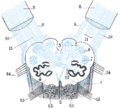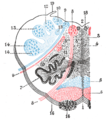Arcuate nucleus (medulla)
Appearance
| Arcuate nucleus (medulla) | |
|---|---|
 Transverse section of medulla oblongata below the middle of the olive. ("Nucleus arcuatus" visible near bottom right.) | |
 Dissection of brain-stem. Lateral view. (Labels for "External arcuate fibers" and "Dorsal external arcuate fibers" visible at lower right.) | |
| Details | |
| Identifiers | |
| Latin | nucleus arcuatus medullae oblongatae |
| NeuroNames | 775 |
| NeuroLex ID | birnlex_2635 |
| TA98 | A14.1.04.256 |
| TA2 | 6016 |
| FMA | 72609 |
| Anatomical terms of neuroanatomy | |
In the medulla oblongata, the arcuate nucleus is a group of neurons located on the anterior surface of the medullary pyramids. These nuclei are the extension of the pontine nuclei.[1]
They receive afferents from the corticospinal tract.[citation needed]
They in turn project efferents into the cerebellum through the inferior cerebellar peduncle as:[1]
- the anterior internal arcuate fibers which pass along the midline before decussating near the rhomboid fossa (floor of fourth ventricle) then passing laterally as the medullary striae;
- the anterior external arcuate fibers.
Function
[edit]Arcuate nuclei are capable of chemosensitivity and have a proven role in the respiratory center controlling the breathing rate.[2]
Additional images
[edit]-
Diagram showing the course of the arcuate fibers.
-
The formatio reticularis of the medulla oblongata, shown by a transverse section passing through the middle of the olive.
External links
[edit]References
[edit]- ^ a b Standring, Susan (2020). Gray's Anatomy: The Anatomical Basis of Clinical Practice (42th ed.). New York: Elsevier. p. 445.e1. ISBN 978-0-7020-7707-4. OCLC 1201341621.
- ^ Paradiso, B; Ferrero, S; Thiene, G; Lavezzi, AM (November 2018). "Variability of the medullary arcuate nucleus in humans". Brain and Behavior. 8 (11): e01133. doi:10.1002/brb3.1133. hdl:11577/3281424. PMID 30329220.

